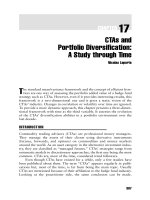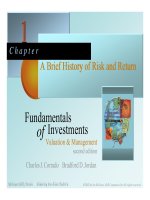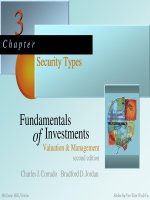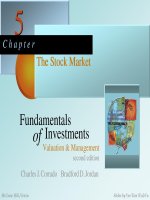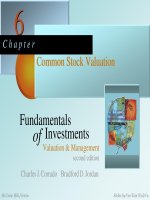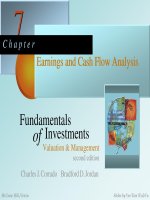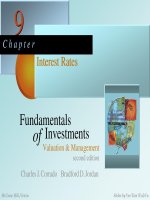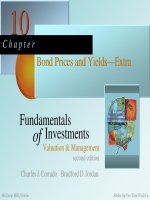Charles J. Corrado_Fundamentals of Investments - Chapter 17 ppsx
Bạn đang xem bản rút gọn của tài liệu. Xem và tải ngay bản đầy đủ của tài liệu tại đây (667.04 KB, 58 trang )
1
This quote has been attributed to both Mark Twain (The Tragedy of Pudd’nhead
Wilson, 1894) and Andrew Carnegie (How to Succeed in Life, 1903).
CHAPTER 17
Diversification and Asset Allocation
Intuitively, we all know that diversification is important for managing
investment risk. But how exactly does diversification work, and how can we
be sure we have an efficiently diversified portfolio? Insightful answers can be
gleaned from the modern theory of diversification and asset allocation.
In this chapter, we examine the role of diversification and asset allocation in investing. Most
of us have a strong sense that diversification is important. After all, “Don’t put all your eggs in one
basket” is a bit of folk wisdom that seems to have stood the test of time quite well. Even so, the
importance of diversification has not always been well understood. For example, noted author and
market analyst Mark Twain recommended: “Put all your eggs in the one basket and—WATCH
THAT BASKET!” This chapter shows why this was probably not Twain’s best piece of advice.
1
As we will see, diversification has a profound effect on portfolio risk and return. The role and
impact of diversification were first formally explained in the early 1950's by financial pioneer Harry
Markowitz, who shared the 1986 Nobel Prize in Economics for his insights. The primary goal of this
chapter is to explain and explore the implications of Markowitz’s remarkable discovery.
2 Chapter 17
17.1 Expected Returns and Variances
In Chapter 1, we discussed how to calculate average returns and variances using historical
data. We now begin to discuss how to analyze returns and variances when the information we have
concerns future possible returns and their probabilities.
Expected Returns
We start with a straightforward case. Consider a period of time such as a year. We have two
stocks, say Netcap and Jmart. Netcap is expected to have a return of 25 percent in the coming year;
Jmart is expected to have a return of 20 percent during the same period.
In a situation such as this, if all investors agreed on these expected return values, why would
anyone want to hold Jmart? After all, why invest in one stock when the expectation is that another
will do better? Clearly, the answer must depend on the different risks of the two investments. The
return on Netcap, although it is expected to be 25 percent, could turn out to be significantly higher
or lower. Similarly, Jmart’s realized return could be significantly higher or lower than expected.
For example, suppose the economy booms. In this case, we think Netcap will have a
70 percent return. But if the economy tanks and enters a recession, we think the return will be
-20 percent. In this case, we say that there are two states of the economy, which means that there are
two possible outcomes. This scenario is oversimplified of course, but it allows us to illustrate some
key ideas without a lot of computational complexity.
Suppose we think boom and recession are equally likely to happen, that is, a 50-50 chance
of each outcome. Table 17.1 illustrates the basic information we have described and some additional
Diversification 3
information about Jmart. Notice that Jmart earns 30 percent if there is a recession and 10 percent if
there is a boom.
Table 17.1 States of the Economy and Stock Returns
Security Returns
if State Occurs
State of
Economy
Probability of State
of Economy
Netcap Jmart
Recession .50 -20% 30%
Boom .50 70 10
1.00
Obviously, if you buy one of these stocks, say, Jmart, what you earn in any particular year
depends on what the economy does during that year. Suppose these probabilities stay the same
through time. If you hold Jmart for a number of years, you’ll earn 30 percent about half the time and
10 percent the other half. In this case, we say your expected return on Jmart, E(R
J
), is 20 percent:
E(R
J
) = .50 × 30% + .50 × 10% = 20%
In other words, you should expect to earn 20 percent from this stock, on average.
(marg. def. expected return Average return on a risky asset expected in the future.)
For Netcap, the probabilities are the same, but the possible returns are different. Here we lose
20 percent half the time, and we gain 70 percent the other half. The expected return on Netcap, E(R
N
)
is thus 25 percent:
E(R
N
) = .50 × -20% + .50 × 70% = 25%
Table 17.2 illustrates these calculations.
4 Chapter 17
Table 17.2 Calculating Expected Returns
Netcap Jmart
(1)
State of
Economy
(2)
Probability of
State of Economy
(3)
Return if
State
Occurs
(4)
Product
(2) × (3)
(5)
Return if
State
Occurs
(6)
Product
(2) × (5)
Recession 0.50 -20% 10 30% .15
Boom 0.50 70 .35 10 .05
1.00 E(R
N
) = 25% E(R
J
) = 20%
In Chapter 1, we defined a risk premium as the difference between the returns on a risky
investment and a risk-free investment, and we calculated the historical risk premiums on some
different investments. Using our projected returns, we can calculate the projected or expected risk
premium as the difference between the expected return on a risky investment and the certain return
on a risk-free investment.
For example, suppose risk-free investments are currently offering 8 percent. We will say that
the risk-free rate, which we label R
f
, is 8 percent. Given this, what is the projected risk premium on
Jmart? On Netcap? Since the expected return on Jmart, E(R
J
), is 20 percent, the projected risk
premium is
Risk premium = Expected return - Risk-free rate [17.1]
= E(R
J
) - R
f
= 20% - 8%
= 12%
Similarly, the risk premium on Netcap is 25% - 8% = 17%.
In general, the expected return on a security or other asset is simply equal to the sum of the
possible returns multiplied by their probabilities. So, if we have 100 possible returns, we would
Diversification 5
multiply each one by its probability and then add up the results. The sum would be the expected
return. The risk premium would then be the difference between this expected return and the risk-free
rate.
Example 17.1 Unequal Probabilities. Look again at Tables 17.1 and 17.2. Suppose you thought a
boom would occur 20 percent of the time instead of 50 percent. What are the expected returns on
Netcap and Jmart in this case? If the risk-free rate is 10 percent, what are the risk premiums?
The first thing to notice is that a recession must occur 80 percent of the time (1 - .20 = .80)
since there are only two possibilities. With this in mind, Jmart has a 30 percent return in 80 percent
of the years and a 10 percent return in 20 percent of the years. To calculate the expected return, we
just multiply the possibilities by the probabilities and add up the results:
E(R
J
) = .80 × 30% + .20 × 10% = 26%
Table 17.3 summarizes the calculations for both stocks. Notice that the expected return on Netcap
is -2 percent.
Table 17.3 Calculating Expected Returns
Netcap Jmart
(1)
State of
Economy
(2)
Probability of
State of Economy
(3)
Return if
State
Occurs
(4)
Product
(2) × (3)
(5)
Return if
State
Occurs
(6)
Product
(2) × (5)
Recession 0.80 -20% 16 30% .24
Boom 0.20 70 .14 10 .02
1.00 E(R
N
) = -2% E(R
J
) = 26%
The risk premium for Jmart is 26% - 10% = 16% in this case. The risk premium for Netcap is
negative: -2% - 10% = -12%. This is a little unusual, but, as we will see, it’s not impossible.
Calculating the Variance
To calculate the variances of the returns on our two stocks, we first determine the squared
deviations from the expected return. We then multiply each possible squared deviation by its
probability. Next we add these up, and the result is the variance.
6 Chapter 17
To illustrate, one of our stocks above, Jmart, has an expected return of 20 percent. In a given
year, the return will actually be either 30 percent or 10 percent. The possible deviations are thus
30%-20% = 10% or 10% - 20% = -10%. In this case, the variance is
Variance =
2
= .50 × (10%)
2
+ .50 × (-10%)
2
= .01
The standard deviation is the square root of this:
Standard deviation =
= .01 = .10 = 10%
Table 17.4 summarizes these calculations and the expected return for both stocks. Notice that
Netcap has a much larger variance. Netcap has the higher return, but Jmart has less risk. You could
get a 70 percent return on your investment in Netcap, but you could also lose 20 percent. Notice that
an investment in Jmart will always pay at least 10 percent.
Table 17.4 Expected Returns and Variances
Netcap Jmart
Expected return, E(R) 25% 20%
Variance,
2
.2025 .0100
Standard deviation,
45% 10%
Which of these stocks should you buy? We can’t really say; it depends on your personal
preferences regarding risk and return. We can be reasonably sure, however, that some investors
would prefer one and some would prefer the other.
You’ve probably noticed that the way we calculated expected returns and variances here is
somewhat different from the way we did it in Chapter 1 (and, probably, different from the way you
learned it in “sadistics”). The reason is that we were examining historical returns in Chapter 1, so we
Diversification 7
estimated the average return and the variance based on some actual events. Here, we have projected
future returns and their associated probabilities, so this is the information with which we must work.
Example 17.2 More Unequal Probabilities. going back to Table 17.3 in Example 17.1, what are the
variances on our two stocks once we have unequal probabilities? What are the standard deviations?
We can summarize the needed calculations as follows:
(1)
State
of Economy
(2)
Probability of
State of
Economy
(3)
Return Deviation
from Expected
Return
(4)
Squared
Return
Deviation
(5)
Product
(2) × (4)
Netcap
Recession .80 20 - ( 02) = 18 .0324 .02592
Boom .20 .70 - ( 02) = .72 .5184 .10368
2
N
= .12960
Jmart
Recession .80 .30 - .26 = .04 .0016 .00128
Boom .20 .10 - .26 = 16 .0256 .00512
2
J
= .00640
Based on these calculations, the standard deviation for Netcap is
N
=
.1296 = 36%. The standard
deviation for Jmart is much smaller,
J
=
.0064, or 8 percent.
CHECK THIS
17.1a How do we calculate the expected return on a security?
17.1b In words, how do we calculate the variance of an expected return?
8 Chapter 17
2
Some of it could be in cash, of course, but we would then just consider cash to be another
of the portfolio assets.
(marg. def. portfolio Group of assets such as stocks and bonds held by an investor.)
17.2 Portfolios
Thus far in this chapter, we have concentrated on individual assets considered separately.
However, most investors actually hold a portfolio of assets. All we mean by this is that investors tend
to own more than just a single stock, bond, or other asset. Given that this is so, portfolio return and
portfolio risk are of obvious relevance. Accordingly, we now discuss portfolio expected returns and
variances.
(marg. def. portfolio weight Percentage of a portfolio’s total value invested in a
particular asset.)
Portfolio Weights
There are many equivalent ways of describing a portfolio. The most convenient approach is
to list the percentages of the total portfolio’s value that are invested in each portfolio asset. We call
these percentages the portfolio weights.
For example, if we have $50 in one asset and $150 in another, then our total portfolio is worth
$200. The percentage of our portfolio in the first asset is $50/$200 = .25. The percentage of our
portfolio in the second asset is $150/$200 = .75. Notice that the weights sum up to 1.00 since all of
our money is invested somewhere.
2
Diversification 9
Portfolio Expected Returns
Let’s go back to Netcap and Jmart. You put half your money in each. The portfolio weights
are obviously .50 and .50. What is the pattern of returns on this portfolio? The expected return?
To answer these questions, suppose the economy actually enters a recession. In this case, half
your money (the half in Netcap) loses 20 percent. The other half (the half in Jmart) gains 30 percent.
Your portfolio return, R
P
, in a recession will thus be:
R
P
= .50 × -20% + .50 × 30% = 5%
Table 17.5 summarizes the remaining calculations. Notice that when a boom occurs, your portfolio
would return 40 percent:
R
P
= .50 × 70% + .50 × 10% = 40%
As indicated in Table 17.5, the expected return on your portfolio, E(R
P
), is 22.5 percent.
Table 17.5 Expected Portfolio Return
(1)
State of
Economy
(2)
Probability of
State of
Economy
(3)
Portfolio Return if State Occurs
(4)
Product
(2) × (3)
Recession .50 .50 × -20% + .50 × 30% = 5% .025
Boom .50 .50 × 70% + .50 × 10% = 40% .200
E(R
P
) = 22.5%
We can save ourselves some work by calculating the expected return more directly. Given
these portfolio weights, we could have reasoned that we expect half our money to earn 25 percent
10 Chapter 17
(the half in Netcap) and half of our money to earn 20 percent (the half in Jmart). Our portfolio
expected return is thus
E(R
P
) = .50 × E(R
N
) + .50 × E(R
J
)
= .50 × 25% + .50 × 20%
= 22.5%
This is the same portfolio return that we calculated in Table 17.5.
This method of calculating the expected return on a portfolio works no matter how many
assets there are in the portfolio. Suppose we had n assets in our portfolio, where n is any number at
all. If we let x
i
stand for the percentage of our money in Asset i, then the expected return is
E(R
P
) = x
1
× E(R
1
) + x
2
× E(R
2
) + . . . + x
n
× E(R
n
) [17.2]
This says that the expected return on a portfolio is a straightforward combination of the expected
returns on the assets in that portfolio. This seems somewhat obvious, but, as we will examine next,
the obvious approach is not always the right one.
Example 17.3 More Unequal Probabilities. Suppose we had the following projections on three
stocks:
State of
Economy
Probability of
State of
Economy
Returns
Stock A Stock B Stock C
Boom .50 10% 15% 20%
Bust .50 8 4 0
We want to calculate portfolio expected returns in two cases. First, what would be the expected
return on a portfolio with equal amounts invested in each of the three stocks? Second, what would
be the expected return if half of the portfolio were in A, with the remainder equally divided between
B and C?
Diversification 11
From our earlier discussion, the expected returns on the individual stocks are
E(R
A
) = 9.0%
E(R
B
) = 9.5%
E(R
C
) = 10.0%
Check these for practice. If a portfolio has equal investments in each asset, the portfolio weights are
all the same. Such a portfolio is said to be equally weighted. Since there are three stocks in this case,
the weights are all equal to
. The portfolio expected return is thus
E(R
P
) = × 9.0% + × 9.5% + × 10.0% = 9.5%
In the second case, check that the portfolio expected return is 8.4%.
Portfolio Variance
From the preceding discussion, the expected return on a portfolio that contains equal
investments in Netcap and Jmart is 22.5 percent. What is the standard deviation of return on this
portfolio? Simple intuition might suggest that half of our money has a standard deviation of 45
percent, and the other half has a standard deviation of 10 percent. So the portfolio’s standard
deviation might be calculated as follows:
P
= .50 × 45% + .50 × 10% = 27.5%
Unfortunately, this approach is completely incorrect!
Let’s see what the standard deviation really is. Table 17.6 summarizes the relevant
calculations. As we see, the portfolio’s variance is about .031, and its standard deviation is less than
we thought—it’s only 17.5 percent. What is illustrated here is that the variance on a portfolio is not
generally a simple combination of the variances of the assets in the portfolio.
12 Chapter 17
3
Earlier, we had a risk-free rate of 8 percent. Now we have, in effect, a 20.91 percent risk-
free rate. If this situation actually existed, there would be a very profitable arbitrage opportunity!
In reality, we expect that all riskless investments would have the same return.
Table 17.6 Calculating Portfolio Variance
(1)
State of
Economy
(2)
Probability of
State of
Economy
(3)
Portfolio
Returns if
State Occurs
(4)
Squared Deviation from
Expected Return
(5)
Product
(2) × (4)
Recession .50 5% (.05 - .225)
2
= .030625 .0153125
Boom .50 40 (.40 - .225)
2
= .030625 .0153125
2
P
= .030625
P
=
.030625 = 17.5%
We can illustrate this point a little more dramatically by considering a slightly different set of
portfolio weights. Suppose we put 2/11 (about 18 percent) in Netcap and the other 9/11 (about 82
percent) in Jmart. If a recession occurs, this portfolio with have a return of
R
P
= 2/11 × -20% + 9/11 × 30% = 20.91%
If a boom occurs, this portfolio will have a return of
R
P
= 2/11 × 70% + 9/11 × 10% = 20.91%
Notice that the return is the same no matter what happens. No further calculation is needed: This
portfolio has a zero variance and no risk!
This is a nice bit of financial alchemy. We take two quite risky assets and by mixing them just
right, we create a riskless portfolio. It seems very clear that combining assets into portfolios can
substantially alter the risks faced by an investor. This is a crucial observation, and we will begin to
explore its implications in the next section.
3
Diversification 13
Example 17.4 Portfolio Variance and Standard Deviations. In Example 17.3, what are the standard
deviations of the two portfolios?
To answer, we first have to calculate the portfolio returns in the two states. We will work
with the second portfolio, which has 50 percent in Stock A and 25 percent in each of Stocks B and
C. The relevant calculations are summarized as follows:
State of
the
Economy
Probability of
State of the
Economy
Returns
Stock A Stock B Stock C Portfolio
Boom .50 10% 15% 20% 13.75%
Bust .50 8 4 0 5.00
The portfolio return when the economy booms is calculated as
R
P
= .50 × 10% + .25 × 15% + .25 × 20% = 13.75%
The return when the economy goes bust is calculated the same way. Check that it’s 5 percent and also
check that the expected return on the portfolio is 8.5 percent. The variance is thus
2
P
= .40 × (.1375 - .085)
2
+ .60 × (.05 - .085)
2
= .0018375
The standard deviation is thus about 4.3 percent. For our equally weighted portfolio, redo these
calculations and check that the standard deviation is about 5.4 percent.
CHECK THIS
17.2a What is a portfolio weight?
17.2b How do we calculate the variance of an expected return?
17.3 Diversification and Portfolio Risk
Our discussion to this point has focused on some hypothetical securities. We’ve seen that
portfolio risks can, in principle, be quite different from the risks of the assets that make up the
portfolio. We now look more closely at the risk of an individual asset versus the risk of a portfolio
14 Chapter 17
Table 17.7 about here
of many different assets. As we did in Chapter 1, we will examine some stock market history to get
an idea of what happens with actual investments in U.S. capital markets.
The Effect of Diversification: Another Lesson from Market History
In Chapter 1, we saw that the standard deviation of the annual return on a portfolio of large
common stocks was about 20 percent per year. Does this mean that the standard deviation of the
annual return on a typical stock in that group is about 20 percent? As you might suspect by now, the
answer is no. This is an extremely important observation.
To examine the relationship between portfolio size and portfolio risk, Table 17.7 illustrates
typical average annual standard deviations for equally weighted portfolios that contain different
numbers of randomly selected NYSE securities.
In column 2 of Table 17.7, we see that the standard deviation for a “portfolio” of one security
is just under 50 percent per year at 49.24 percent. What this means is that if you randomly select a
single NYSE stock and put all your money into it, your standard deviation of return would typically
have been about 50 percent per year. Obviously, such a strategy has significant risk! If you were to
randomly select two NYSE securities and put half your money in each, your average annual standard
deviation would have been about 37 percent.
The important thing to notice in Table 17.7 is that the standard deviation declines as the
number of securities is increased. By the time we have 100 randomly chosen stocks (and 1 percent
invested in each), the portfolio’s volatility has declined by 60 percent, from 50 percent per year to 20
Diversification 15
Figure 17.1 about here
percent per year. With 500 securities, the standard deviation is 19.27 percent per year, similar to the
20 percent per year we saw in Chapter 1 for large common stocks. The small difference exists
because the portfolio securities, portfolio weights, and the time periods covered are not identical.
The Principle of Diversification
Figure 17.1 illustrates the point we’ve been discussing. What we have plotted is the standard
deviation of the return versus the number of stocks in the portfolio. Notice in Figure 17.1 that the
benefit in terms of risk reduction from adding securities drops off as we add more and more. By the
time we have 10 securities, most of the diversification effect is already realized, and by the time we
get to 30 or so, there is very little remaining benefit. In other words, the benefit of further
diversification increases at a decreasing rate, so the “law of diminishing returns” applies here as it
does in so many other places.
(marg. def. principle of diversification Spreading an investment across a number of
assets will eliminate some, but not all, of the risk.)
Figure 17.1 illustrates two key points. First, some of the riskiness associated with individual
assets can be eliminated by forming portfolios. The process of spreading an investment across assets
(and thereby forming a portfolio) is called diversification. The principle of diversification tells us
that spreading an investment across many assets will eliminate some of the risk. Not surprisingly, risks
that can be eliminated by diversification are called “diversifiable” risks.
16 Chapter 17
The second point is equally important. There is a minimum level of risk that cannot be
eliminated by simply diversifying. This minimum level is labeled “nondiversifiable risk” in Figure 17.1.
Taken together, these two points are another important lesson from financial market history:
Diversification reduces risk, but only up to a point. Put another way, some risk is diversifiable and
some is not.
CHECK THIS
17.3a What happens to the standard deviation of return for a portfolio if we increase the number of
securities in the portfolio?
17.3b What is the principle of diversification?
17.4 Correlation and Diversification
We’ve seen that diversification is important. What we haven’t discussed is how to get the
most out of diversification. For example, in our previous section, we investigated what happens if we
simply spread our money evenly across randomly chosen stocks. We saw that significant risk
reduction resulted from this strategy, but you might wonder whether even larger gains could be
achieved by a more sophisticated approach. As we begin to examine that question here, the answer
is yes.
Diversification 17
Figure 17.2 about here
(marg. def. correlation The tendency of the returns on two assets to move together.)
Why Diversification Works
Why diversification reduces portfolio risk as measured by the portfolio standard deviation is
important and worth exploring in some detail. The key concept is correlation, which is the extent to
which the returns on two assets move together. If the returns on two assets tend to move up and
down together, we say they are positively correlated. If they tend to move in opposite directions, we
say they are negatively correlated. If there is no particular relationship between the two assets, we
say they are uncorrelated.
The correlation coefficient, which we use to measure correlation, ranges from -1 to +1, and
we will denote the correlation between the returns on two assets, say A and B, as Corr(R
A
, R
B
). The
Greek letter (rho) is often used to designate correlation as well. A correlation of +1 indicates that
the two assets have a perfect positive correlation. For example, suppose that whatever return Asset A
realizes, either up or down, Asset B does the same thing by exactly twice as much. In this case, they
are perfectly correlated because the movement on one is completely predictable from the movement
on the other. Notice, however, that perfect correlation does not necessarily mean they move by the
same amount.
A zero correlation means that the two assets are uncorrelated. If we know that one asset is
up, then we have no idea what the other one is likely to do; there simply is no relation between them.
Perfect negative correlation (Corr(R
A
, R
B
) = -1) indicates that they always move in opposite
directions. Figure 17.2 illustrates the three benchmark cases of perfect positive, perfect negative, and
zero correlation.
18 Chapter 17
Diversification works because security returns are generally not perfectly correlated. We will
be more precise about the impact of correlation on portfolio risk in just a moment. For now, it is
useful to simply think about combining two assets into a portfolio. If the two assets are highly
correlated (the correlation is near +1), then they have a strong tendency to move up and down
together. As a result, they offer limited diversification benefit. For example, two stocks from the same
industry, say, General Motors and Ford, will tend to be relatively highly correlated since the
companies are in essentially the same business, and a portfolio of two such stocks is not likely to be
very diversified.
In contrast, if the two assets are negatively correlated, then they tend to move in opposite
directions; whenever one zigs, the other tends to zag. In such a case, there will be substantial
diversification benefit because variation in the return on one asset tends to be offset by variation in
the opposite direction from the other. In fact, if two assets have a perfect negative correlation
(Corr(R
A
, R
B
) = -1) then it is possible to combine them such that all risk is eliminated. Looking back
at our example involving Jmart and Netcap in which we were able to eliminate all of the risk, what
we now see is that they must be perfectly negatively correlated.
Table 17.8 Annual Returns on Stocks A and B
Year Stock A Stock B Portfolio AB
1995 10% 15% 12.5%
1996 30 -10 10
1997 -10 25 7.5
1998 5 20 12.5
1999 10 15 12.5
Average returns 9% 13% 11%
Standard deviations 14.3% 13.5% 2.2%
Diversification 19
Figure 17.3 about here
To further illustrate the impact of diversification on portfolio risk, suppose we observed the
actual annual returns on two stocks, A and B, for the years 1995 - 1999. We summarize these returns
in Table 17.8: In addition to actual returns on stocks A and B, we also calculated the returns on an
equally weighted portfolio of A and B. We label this portfolio as AB. In 1996, for example, Stock A
returned 10 percent and Stock B returned 15 percent. Since Portfolio AB is half invested in each, its
return for the year was
½ × 10% + ½ × 15% = 12.5%
The returns for the other years are calculated similarly.
At the bottom of Table 17.8, we calculated the average returns and standard deviations on
the two stocks and the equally-weighted portfolio. These averages and standard deviations are
calculated just as they were in Chapter 1 (check a couple just to refresh your memory). The impact
of diversification is apparent. The two stocks have standard deviations in the 13 percent to 14 percent
per year range, but the portfolio’s volatility is only 2.2 percent. In fact, if we compare the portfolio
to Stock B, it has a higher return (11 percent versus 9 percent) and much less risk.
Figure 17.3 illustrates in more detail what is occurring with our example. Here we have three
bar graphs showing the year-by-year returns on Stocks A and B and Portfolio AB. Examining the
graphs, we see that in 1996, for example, Stock A earned 30 percent while Stock B lost 10 percent.
The following year, Stock B earned 25 percent while A lost 10 percent. These ups and downs tend
to cancel out in our portfolio, however, with the result that there is much less variation in return from
year to year. In other words, the correlation between the returns on stocks A and B is relatively low.
20 Chapter 17
2
P
x
2
A
2
A
x
2
B
2
B
2 x
A
x
B
A
B
Corr(R
A
,R
B
)
[17.3]
2
P
.50
2
×.40
2
.50
2
×.60
2
2×.50×.50×.40×.60×.15
.25×.16 .25×.36 .018
.148
Calculating the correlation between stocks A and B is not difficult, but it would require us to
digress a bit. Instead, we will explain the needed calculation in the next chapter where we build on
the principles developed here.
Calculating Portfolio Risk
We’ve seen that correlation is an important determinant of portfolio risk. To further pursue
this issue, we need to know how to calculate portfolio variances directly. For a portfolio of two
assets, A and B, the variance of the return on the portfolio,
2
P
, is given by Equation 17.3:
In this equation, x
A
and x
B
are the percentages invested in assets A and B. Notice that x
A
+ x
B
= 1
(Why?).
Equation 17.3 looks a little involved, but its use is straightforward. For example, suppose
Stock A has a standard deviation of 40 percent per year and Stock B has a standard deviation of
60 percent per year. The correlation between them is .15. If you put half your money in each, what
is your portfolio standard deviation?
To answer, we just plug the numbers in to Equation 17.3. Note that x
A
and x
B
are each equal
to .50, while
A
and
B
are .40 and .60, respectively. Taking Corr(R
A
, R
B
) = .15, we have
Diversification 21
P
.148 .3847 38.47%
2
P
.25
2
×.40
2
.75
2
×.60
2
2×.25×.75×.40×.60×.35
.0625×.16 .5625×.36 .0315
.244
P
.244 .49396 49%
Thus, the portfolio variance is .148. As always, variances are not easy to interpret since they are
based on squared returns, so we calculate the standard deviation by taking the square root:
Once again, we see the impact of diversification. This portfolio has a standard deviation of 38.47
percent, which is less than either of the standard deviations on the two assets that are in the portfolio.
Example 17.5 Portfolio Variance and Standard Deviation. In the example we just examined, Stock A
has a standard deviation of 40 percent per year and Stock B has a standard deviation of 60 percent
per year. Suppose now that the correlation between them is .35. Also suppose you put one-fourth of
your money in Stock A. What is your portfolio standard deviation?
If you put ¼ (or .25) in Stock A, you must have ¾ (or .75) in Stock B, so x
A
= .25 and
x
B
= .75. Making use of our portfolio variance equation (17.3), we have
Thus the portfolio variance is .244. Taking the square root, we get
This portfolio has a standard deviation of 49 percent, which is between the individual standard
deviations. This shows that a portfolio’s standard deviation isn’t necessarily less than the individual
standard deviations.
To illustrate why correlation is an important, practical, real-world consideration, suppose that
as a very conservative, risk-averse investor, you decide to invest all of your money in a bond mutual
fund. Based on your analysis, you think this fund has an expected return of 6 percent with a standard
deviation of 10 percent per year. A stock fund is available, however, with an expected return of 12
22 Chapter 17
percent, but the standard deviation of 15 percent is too high for your taste. Also, the correlation
between the returns on the two funds is about .10.
Is the decision to invest 100 percent in the bond fund a wise one, even for a very risk-averse
investor? The answer is no; in fact, it is a bad decision for any investor. To see why, Table 17.9 shows
expected returns and standard deviations available from different combinations of the two mutual
funds. In constructing the table, we begin with 100 percent in the stock fund and work our way down
to 100 percent in bond fund by reducing the percentage in the stock fund in increments of .05. These
calculations are all done just like our examples just above; you should check some (or all) of them
for practice.
Diversification 23
Table 17.9 Risk and Return with Stocks and Bonds
Portfolio Weights Expected Standard
Stocks Bonds Return Deviation
1.00 0.00 12.00% 15.00%
0.95 0.05 11.70 14.31
0.90 0.10 11.40 13.64
0.85 0.15 11.10 12.99
0.80 0.20 10.80 12.36
0.75 0.25 10.50 11.77
0.70 0.30 10.20 11.20
0.65 0.35 9.90 10.68
0.60 0.40 9.60 10.28
0.55 0.45 9.30 9.78
0.50 0.50 9.00 9.42
0.45 0.55 8.70 9.12
0.40 0.60 8.40 8.90
0.35 0.65 8.10 8.75
0.30 0.70 7.80 8.69
0.25 0.75 7.50 8.71
0.20 0.80 7.20 8.82
0.15 0.85 6.90 9.01
0.10 0.90 6.60 9.27
0.05 0.95 6.30 9.60
0.00 1.00 6.00 10.00
Beginning on the first row in Table 17.9, we have 100 percent in the stock fund, so our
expected return is 12 percent, and our standard deviation is 15 percent. As we begin to move out of
the stock fund and into the bond fund, we are not surprised to see both the expected return and the
standard deviation decline. However, what might be surprising to you is the fact that the standard
deviation falls only so far and then begins to rise again. In other words, beyond a point, adding more
of the lower risk bond fund actually increases your risk!
24 Chapter 17
Figure 17.4 about here
The best way to see what is going on is to plot the various combinations of expected returns
and standard deviations calculated in Table 17.9 as do in Figure 17.4. We simply placed the standard
deviations from Table 17.9 on the horizontal axis and the corresponding expected returns on the
vertical axis.
(marg. def. investment opportunity set Collection of possible risk-return
combinations available from portfolios of individual assets)
Examining the plot in Figure 17.4, we see that the various combinations of risk and return
available all fall on a smooth curve (in fact, for the geometrically inclined, it’s a hyperbola). This curve
is called an investment opportunity set because it shows the possible combinations of risk and
return available from portfolios of these two assets. One important thing to notice is that, as we have
shown, there is a portfolio that has the smallest standard deviation (or variance - same thing) of all.
It is labeled “minimum variance portfolio” in Figure 17.4. What are (approximately) its expected
return and standard deviation?
Now we see clearly why a 100 percent bonds strategy is a poor one. With a 10 percent
standard deviation, the bond fund offers an expected return of 6 percent. However, Table 17.9 shows
us that a combination of about 60 percent stocks and 40 percent bonds has almost the same standard
deviation, but a return of about 9.6 percent. Comparing 9.6 percent to 6 percent, we see that this
portfolio has a return that is fully 60 percent greater (6% × 1.6 = 9.6%) with the same risk. Our
conclusion? Asset allocation matters.
Diversification 25
Investment Update: Forbes Egg basket analysis
2
P
.57627
2
×.15
2
.42373
2
×.10
2
2×.57627×.42373×.15×.10×.10
.332×.0225 .180×.01 .0007325
.01
Given the apparent importance of asset allocation, it is not too surprising to learn that this
analysis is becoming widespread in investment practice. The nearby Investment Updates box presents
an article from Forbes discussing its use for mutual fund investors. Notice how closely the discussion
tracks our development.
Going back to Figure 17.4, notice that any portfolio that plots below the minimum variance
portfolio is a poor choice because, no matter which one you pick, there is another portfolio with the
same risk and a much better return. In the jargon of finance, we say that these undesirable portfolios
are dominated and/or inefficient. Either way, we mean that given their level of risk, the expected
return is inadequate compared to some other portfolio of equivalent risk. A portfolio that offers the
highest return for its level of risk is said to be an efficient portfolio. In Figure 17.4, the minimum
variance portfolio and all portfolios that plot above it are therefore efficient.
(marg. def. efficient portfolio A portfolio that offers the highest return for its level
of risk.)
Example 17.6 More Portfolio Variance and Standard Deviation. Looking at Table 17.9, suppose you
put 57.627 percent in the stock fund. What is your expected return? Your standard deviation? How
does this compare with the bond fund?
If you put 57.627 percent in stocks, you must have 42.373 percent in bonds, so x
A
= .57627
and x
B
= .42373. Making use of our portfolio variance equation (17.3), we have
Thus the portfolio variance is .01, so the standard deviation is .1 or 10 percent. Check that the
expected return is 9.46 percent. Compared to the bond fund, the standard deviation is now identical,
but the expected return is almost 350 basis points higher.
